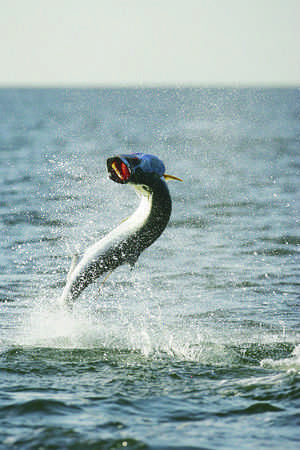Flip Pallot
Now it’ summer and for the next month or so warming water temperatures will dictate changes in our fishing techniques. These changes will vary based upon our location relative to the Mason/Dixon line, but we will be making some tactical changes to accommodate the warmer water.
In the extreme southeastern part of the country, summer water can get extremely warm, often reaching close to 100 degrees in the shallows and well into the 80’s offshore. This climbing water temperature gives rise to one of the most exciting 
Prior to the actual beginning of the migration, tarpon are known to “Lay Up”; a condition where tarpon actually lay motionless on the surface of calm, usually deeper water (five to twelve foot depths). These tarpon appear to have been zapped with tasers and do not move so much as an inch…. that is until you carefully present a fly, allow it to sink just a bit, twitch it ever so slightly (shrimp like), and then…POW…..Look out! The sleeping giant comes to life, eats the fly and is off jumping over the horizon as only a 100-pound plus tarpon can do!
Fishing “Laid Up Fish” calls for floating lines and fairly large, buoyant flies, which work slowly and tend not too sink to quickly. Laid up fish are harder to find as the water warms above 82 degrees. Indeed, many tarpon begin their breeding and/or migration at that point. Once the tarpon begin moving north, tactics generally change and employ the use of slow or intermediate sinking lines and smaller, more sparsely dressed flies. My favorite tactic at this time of year is to use a mono-core, slow sink fly line. This line is perfectly clear and can be cast into the middle of large, migrating schools of tarpon without spooking them. Using this line and smaller flies I often pick a fish in the middle of a school and fish for him or her without being concerned about spooking the fish on either side of the target fish. I hasten to add that you don’t always have control over which fish within a school eats the fly… but it’s nice to have a plan. Many other species don’t take the summer off, but change their patterns. Redfish, snook, bonefish, permit, snapper and smaller resident tarpon frequent the shallows early and late in the day, during cooler periods, or at higher tide stages.
During mid day, low tide periods, when water is at its warmest, many of these species fade into deeper channels adjacent to the flats. Oceanside fish simply slide off the shallows into the deeper, cooler world oceanward of the flats.In Florida and the Caribbean, where even deep water is fairly shallow, the two major tactical changes needed to cope with warming water involve weighted flies and sinking fly lines. One of the most important weighted flies to come along in many, many mango seasons is the Clouser Deep Minnow, developed by Bob Clouser, who is a smallmouth guide on the Susquehanna river in Pennsylvania. Here’s a fly that lets you get down to the mudding level of bonefish and permit on the higher, cooler tide stages, but still allows you the luxury of using a floating fly line.
If you’re fishing blind in deeper channels, team the Clouser up with a sinking line and a very short (3-5 foot) leader and you can encounter snook, redfish, mangrove snapper and many other species lurking in the cooler depths. Offshore, unless you’ve teased or chummed fish to the surface, you will find yourself using a “deep water express” or lead core shooting head to get down to depths as great as 60-90 feet to reach bottom dwellers intent upon escaping the heat of surface waters. As you move further north along the Atlantic Coast, warmer water can mean that the variety of fish may dramatically increase or that expected species may show up earlier or later depending upon the arrival of the warmer water.
Long time friend and coastal fly fishing master, Ed Jawarowsky, maintains that the arrival of warm water to his coast (Chesapeake Bay to Maine) rings in the arrival of baitfish. Really warm years, according to Ed, bring in tremendous numbers of bait pods and to fill the vacuum created by their not being elsewhere, game fish that don’t normally show up in cooler years, present themselves in legions to feed upon these migrations of baitfish. Ed recalls three separate weeks at Barnegat Bay when bait netters captured baby bonefish in their nets… some fifteen hundred miles north of their usual stomping grounds. He also remembers large numbers of jack cravelle being taken in the Hudson River; and pompano and Spanish mackerel taken on flies in the Massachusetts surf.
Tactical changes needed to fish for such surprise visitors are not great and merely involve changes in fly size and minor changes in fishing depth based on which visitor presents itself. Probably the most important thing to remember about warming waters, no matter where you encounter them, is that it is a time of transition and migration for both game fish and baitfish alike. Warmer water can appear suddenly as a result of wind or current change. Cooler water can replace it quickly for the same reasons. Successful anglers adapt immediately to such changes and are often rewarded while. Less aware anglers cling to what they were doing yesterday and hope for the best. It’s interesting to note that while fish in southern climes retreat to deeper water in summer to avoid high water temperatures, they do the same in winter to avoid the colder water. In northern climes fish seek shallow water in summer and deeper water in winter. No matter which area of the state or the country you choose to fish, you’ll want to adjust your strategy to water temps.
[easy-social-share]